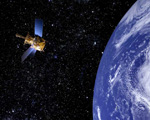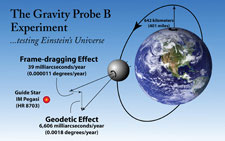WEEKLY UPDATE FOR 1 APRIL 2005:
GRAVITY PROBE B MISSION STATUS AT A GLANCE

| Item | Current Status |
| Mission Elapsed Time | 346 days (49 weeks/11.50 months) |
| Science Data Collection | 217 days (31 weeks/7.11 months) |
| Current Orbit # | 5,10 as of 4:00 PM PST |
| Spacecraft General Health | Good |
| Roll Rate | Normal at 0.7742 rpm (77.5 seconds per revolution) |
| Gyro Suspension System (GSS) | All 4 gyros digitally suspended in science mode |
| Dewar Temperature | 1.82 kelvin, holding steady |
| Global Positioning System (GPS) lock | Greater than 98.3% |
| Attitude & Translation Control (ATC) | X-axis attitude error: 178.8 marcs rms |
| Command & Data Handling (CDH) | B-side (backup) computer in control Multi-bit errors (MBE): 1 (on 3/26) Single-bit errors (SBE): 9 (daily average) |
| Telescope Readout (TRE) | Nominal |
| SQUID Readouts (SRE) | Nominal |
| Gyro #1 rotor potential | -0.5 mV as of 3/21/05 |
| Gyro #2 rotor potential | 9.4 mV as of 3/21/05V |
| Gyro #4 rotor potential | -4.7 mV as of 3/21/05 |
| Gyro #3 Drag-free Status | Backup Drag-free mode (normal) |
MISSION DIRECTOR'S SUMMARY
As of Mission Day 346, the Gravity Probe B vehicle and payload are in good health. All four gyros are digitally suspended in science mode. The spacecraft is flying drag-free around Gyro #3. As of this past week, we have successfully collected more than seven months of relativity data.


Last Saturday, the Gyro Suspension (GSS) computer for gyro #4 reported a multi-bit error (MBE). Upon investigation of this MBE, the GSS team determined that it was in a memory location that would soon be accessed by a program command sequence. To avert the computer reboot problems that the spacecraft has been experiencing for the past three weeks, the team sent commands to the flight computer halting the mission timeline. Then, as described in last week's Mission News, computer specialists used the Integrated Test Facility (ITF) simulator at Lockheed Martin to determine the correct value for the afflicted memory location and uploaded a patch to repair that location. After this repair, the team sent a revised command timeline to the GSS computer and resumed normal operations.


Because of the team's intervention, the guide star lock was not lost and the spacecraft remained in drag-free flight throughout this period. Also, gyro #4 remained digitally suspended in science (data collection) mode. Complete recovery from this MBE took only a few hours, thanks to the diligence of the team.
Investigations into the root causes of the recent spate of MBEs suggests the possibility that the scrub routine which is checking the memory cells of the on-board Command & Control Computer Assembly (CCCA) could trigger a safemode response on a single MBE if that error occurs in certain locations. As a result, the team has re-programmed the safemode response for the MBE test to automatically stop the mission timeline, rather than rebooting the computer.
Also this past week, the GP-B team continued work on the Attitude and Translation Control system (ATC) and the telescope detectors. The purpose of these adjustments is to enable the spacecraft to remain under control of the science gyros (rather than the navigation control gyros) in all orbits through the South Atlantic Anomaly (SAA) region.
MISSION NEWS-EFFECTS OF ANOMALOUS EVENTS ON THE EXPERIMENTAL RESULTS OF GP-B

Whenever anomalous events occur on-board the GP-B spacecraft in orbit, such as computer switchovers and reboots, we receive numerous inquiries asking about the effects of these events on the outcome of the GP-B experiment. As we have reported in past updates, these events have resulted in a small loss of science data. In and of itself, this loss of data will have no significant effect on the results of the experiment. If it turns out that some of the lost data was accompanied by non-relativistic torques on the gyros (measurable drift in the gyro spin axes caused by forces other than relativity), we believe that there will probably be a perceptible, but still insignificant effect on the accuracy of the end results. We really will not be able to quantify the effect of these events until all of the data has been collected (early this summer), instrument re-calibration tests have been run (late this summer) and the full data analysis is completed (sometime next year).
 We have long anticipated and planned for dealing with possible lapses in the data and non-relativistic torques on the gyros during the mission. In fact, this subject was explicitly discussed in Dr. Thierry Duhamel's 1984 PhD thesis entitled “Contributions to the Error Analysis in the Relativity Gyroscope Experiment.” (This was one of 79 Stanford doctoral dissertations sponsored by GP-B over the past 42 years.) Chapter 4 of Dr. Duhamel's dissertation is entitled “Effect of Interruptions in the Data.” In this chapter, Dr. Duhamel modeled various hypothetical cases of an undetermined amount of gyro spin axis drift due to non-relativistic torques (forces) on the gyros, accompanying data interruption periods of varying lengths. Each of Dr. Duhamel's hypothetical scenarios models these effects over a 12-month data collection period, showing the effect of gyro drift and data loss as a function of when in the mission (month 1, month 2, etc.) the event occurs.
We have long anticipated and planned for dealing with possible lapses in the data and non-relativistic torques on the gyros during the mission. In fact, this subject was explicitly discussed in Dr. Thierry Duhamel's 1984 PhD thesis entitled “Contributions to the Error Analysis in the Relativity Gyroscope Experiment.” (This was one of 79 Stanford doctoral dissertations sponsored by GP-B over the past 42 years.) Chapter 4 of Dr. Duhamel's dissertation is entitled “Effect of Interruptions in the Data.” In this chapter, Dr. Duhamel modeled various hypothetical cases of an undetermined amount of gyro spin axis drift due to non-relativistic torques (forces) on the gyros, accompanying data interruption periods of varying lengths. Each of Dr. Duhamel's hypothetical scenarios models these effects over a 12-month data collection period, showing the effect of gyro drift and data loss as a function of when in the mission (month 1, month 2, etc.) the event occurs.
In a nutshell, the results of Dr. Duhamel's research showed that lapses of data in which the gyros do not experience any non-relativistic torques would have no significant effect on the outcome of the experiment. Lapses of data that are accompanied by gyro drifts of unknown size due to non-relativistic forces would have a perceptible, but still relatively small effect on the experimental results. Furthermore, Dr. Duhamel's research indicates that in most cases, the effects of gyro drift and data loss tend to be larger if they occur at the beginning or end of the science phase, rather than in the middle.
Based in part on Dr. Duhamel's prescient research over 20 years ago, the GP-B science team has developed and perfected a comprehensive, state-of-the-art data analysis methodology for the GP-B experiment that, among many other things, takes into account data lapses and the possibility of accompanying non-relativistic torques on the gyros. Also, many improvements have been made in the GP-B technology since Dr. Duhamel did his research. These improvements provide us with more extensive data and extra calibrations that enable us to further refine the original error analysis predictions.
Dr. Thierry Duhamel now lives in France (his native country), where he works for EADS Astrium, a leading European aerospace company.
THE EINSTEIN EXHIBITION AT THE SKIRBALL CULTURAL CENTER IN LOS ANGELES
 If you're going to be in Los Angeles anytime before 30 May 2005, and if you’re interested in Einstein’s life and work, the Einstein Exhibition at the Skirball Cultural Center (just north of the Getty Museum on Interstate 405) is the most comprehensive presentation ever mounted on the life and theories of Albert Einstein (1879-1955). It explores his legacy not only as a scientific genius who re-configured our concepts of space and time, but also as a complex man engaged in the social and political issues of his era. It examines the phenomenon of his fame and his enduring status as a global icon whose likeness has become virtually synonymous with genius.
If you're going to be in Los Angeles anytime before 30 May 2005, and if you’re interested in Einstein’s life and work, the Einstein Exhibition at the Skirball Cultural Center (just north of the Getty Museum on Interstate 405) is the most comprehensive presentation ever mounted on the life and theories of Albert Einstein (1879-1955). It explores his legacy not only as a scientific genius who re-configured our concepts of space and time, but also as a complex man engaged in the social and political issues of his era. It examines the phenomenon of his fame and his enduring status as a global icon whose likeness has become virtually synonymous with genius.
In this exhibit, you can examine Einstein's report card, inspect his FBI file, and enjoy his family photographs, love letters, and diary entries. Exhibition highlights include scientific manuscripts and original correspondence—including original handwritten pages from the 1912 manuscripts of the special theory of relativity and his 1939 letter to President Roosevelt about nuclear power—and a wealth of other documents from the Albert Einstein Archives at the Hebrew University of Jerusalem.



In addition to these displays of Einstein memorabilia, the exhibit also features a number of interactive components that help provide an understanding of Einstein's revolutionary theories. Furthermore, several “explainers,” identified by their red aprons, are on hand to discuss various aspects of the exhibit and to explain and demonstrate difficult concepts, such as time dilation and warped spacetime. At the end of the exhibit, you’ll find one of GP-B’s gyro rotors on display.
The Einstein exhibition was jointly organized by the American Museum of Natural History (AMNH), the Hebrew University of Jerusalem, and the Skirball Cultural Center. It was designed by the AMNH under the supervision of Dr. Michael Shara, curator of the exhibit and chairman of the museum’s Astrophysics Department. It opened in November 2002 at the AMNH in New York and then traveled to Chicago and Boston, spending about 8 months in each location. It will remain at its final U.S. stop at the Skirball Center in Los Angeles through 29 May 2005, after which time it will move permanently to the Hebrew University in Jerusalem.
Information about the Einstein exhibition is available on the Skirball Center Web site. If you can’t make it to Los Angeles, you can visit the AMNH’s virtual Einstein exhibit on the Web.
Drawings and photos: The diagram of the GP-B experiment and the photo collage showing a model of the GP-B spacecraft in orbit were created by GP-B Public Affairs Coordinator, Bob Kahn. Mr. Kahn also took the photos of the GP-B team woking in the Mission Operations Center and the Anomaly Room. The screen capture from the ITF comparing a bad memory location with its correct value is courtesy of Lockheed Martin Corporation. The photo of the cover of Dr. Thierry Duhamel's doctoral dissertation is from the GP-B Image Archive. The photos from the Einstein Exhibit are courtesy of the Skirball Cultural Center. Click on the thumbnails to view these images at full size.
MORE LINKS ON RECENT TOPICS
- Track the satellite in the sky
- Photo, video & and news links
- Build a paper model of the GP-B Spacecraft
- Following the mission online
- Our mailing list - receive the weekly highlights via email
- The GP-B Launch Companion in Adobe Acrobat PDF format. Please note: this file is 1.6 MB, so it may take awhile to download if you have a slow Internet connection.
Previous Highlight
Index of Highlights
